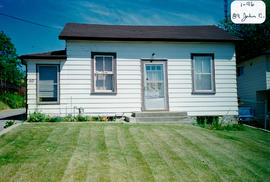The structure located at 29 Holland St. West was vacant for many years. Howard Bowser bought and restored it as a shop with living quarters upstairs. Ted and Audrey Gapp lived here for a number of years. Helen Bantam ran a ladies’ shop downstairs and lived upstairs. She may have bought it from Bowser. At the time of this photo (1995), it was a barber shop.
The building located at 31 and 33 Holland St. West (on the northeast corner of Holland and Moore Streets) was built around 1880 in the Ontario Vernacular style. It was constructed on the site of the former Edmanson Bakery (33 Holland St. West). The bakery was the origin of the big fire on May 23, 1871 that destroyed much of downtown Bradford. E.P. Snow had a harness and saddle shop at 31 Holland St. West for many years. He lived on the north side of John Street. Later it was bought by Secondo Cavallo, who ran a shoemaking business at this location. He lived on the south side of John Street. Cavallo’s daughter (Aida) ran the business for a few years and then it was sold. Lash Davey and Bill ran a butcher shop at 33 Holland St. West for several years. They had a slaughter house on Piccadilly Hill (Simcoe St. South). James Webb, a butcher and lacrosse player, later ran his shop here. Webb was joined by his son Jim, who eventually took over the business and employed Harold Boyd. Jim originally had an ice house at the back of the property. A freezer locker was built later by Len Saint at the back. The building and business were eventually owned for many years by the Pezzanitti family.
The one-storey, commercial, semi-detached ‘row’ building has a wide, rectangular plan with an asymmetrical organization. There is “Main Street” frontage with a typical, storefront façade located at the street line. A plain façade is characterized by a high, flat, ‘boomtown’ façade with brick dentils. The two-bay façade is dominated above the storefronts by an applied, pressed- metal cornice with stone brackets at each end. Existing doors and storefronts are not original. Wide, glass, storefront windows with stone sills are also not original. The building has masonry construction with brick cladding, a stone foundation, and a flat, built-up tar and gravel roof. According to the 2000 inventory, the modest building is in good condition. (1, 2, 3)










